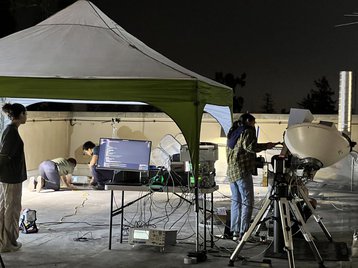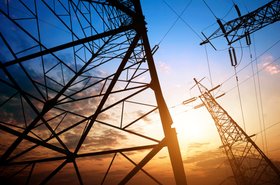Caltech has beamed solar power from a satellite to the Earth, for the first time.
In the Maple (Microwave Array for Power-transfer Low-orbit Experiment) project, a satellite collected solar power and beamed a detectable amount to the roof of the US university. It is the first step in an ambitious project to harvest solar power from space.
Solar power from space is a frankly science-fictional idea, but worth pursuing because in space unlimited solar power is available 24 hours a day with no cloud cover.
Caltech's Space Solar Power Project (SSPP) is a decade-long effort to eventually harvest this solar bounty with a fleet of satellite-borne solar panels, then transform it to microwaves, and beam it to Earth's surface. The project hopes the power can eventually be delivered in useful amounts to locations where clean power is not available.
The project's first satellite, Space Solar Power Demonstrator (SSPD-1), launched in January and aims to demonstrate the feasibility of beaming power to Earth, as well as help choose the best solar panel, and prove the potential to construct a fleet of modular solar harvesting satellites.
The first part of its mission has been achieved by Maple, an array of lightweight microwave power transmitters, that can direct the power beam to any location.
SSPP depends on having a lightweight energy transmission array, which can be folded small and sent into space without requiring a prohibitive amount of fuel, and then automatically unfolded and deployed. Maple, developed by a Caltech team led by Caltech professor Ali Hajimiri, has no moving parts, using interference effects (similar to those used by Wi-Fi hubs) to produce a directional beam.
This is a prototype, so Maple took relatively small steps. First, it transmitted power to a receiver on the satellite, only one foot away from the transmitter. The receiver lit LEDs to show that transmission had occurred, although the equipment was unshielded and subject to the rigors of space.
Maple also beamed energy through a small window, which was detected by a receiver on the roof of the Gordon and Betty Moore Laboratory of Engineering at Caltech's campus in Pasadena.
"Through the experiments we have run so far, we received confirmation that Maple can transmit power successfully to receivers in space," Hajimiri says. "We have also been able to program the array to direct its energy toward Earth, which we detected here at Caltech. We had, of course, tested it on Earth, but now we know that it can survive the trip to space and operate there."
"To the best of our knowledge, no one has ever demonstrated wireless energy transfer in space even with expensive rigid structures. We are doing it with flexible lightweight structures and with our own integrated circuits. This is a first," he added.
The SSPP-1 satellite includes multiple arrays, and the team will assess the performance of individual elements and smaller groups to provide feedback for future production systems.
The final SSPP systems will fold up into packages about 1 cubic meter in volume and unfurl into flat squares about 50 meters per side, with solar cells on one side facing toward the sun and wireless power transmitters on the other side facing toward Earth.
After the success of Maple, the satellite will move on to Dolce (Deployable on-Orbit ultraLight Composite Experiment), a test of the 6 ft packaging for modular spacecraft, and Alba an evaluation of 32 different types of photovoltaic cells in the space environment
"The flexible power transmission arrays are essential to the current design of Caltech's vision for a constellation of sail-like solar panels that unfurl once they reach orbit," says Sergio Pellegrino, Joyce and Kent Kresa professor of Aerospace and Civil Engineering and co-director of SSPP.
"In the same way that the Internet democratized access to information, we hope that wireless energy transfer democratizes access to energy," Hajimiri says. "No energy transmission infrastructure will be needed on the ground to receive this power. That means we can send energy to remote regions and areas devastated by war or natural disaster."
SSPP was kicked off in 2011 by philanthropist Donald Bren, who has pledged more than $100 million to the project. Other sponsors include Northrop Grumman, which has put in $12.5 million over three years.
In the opposite direction, high-altitude pseudo satellite firm Avealto is patterning with Electric Sky to use its Whisper Beam wireless transmissions to power its platforms at latitudes where solar power is less feasible. El-Sky's Whisper Beam system uses a ground array to transmit radio waves straight up to altitudes of 20 km/65,000 feet, where a receiver converts the waves to electricity. Founded in 2013, Avealto is developing high-altitude airships to provide connectivity to remote regions – the platform will reportedly draw as much as 60kW.





